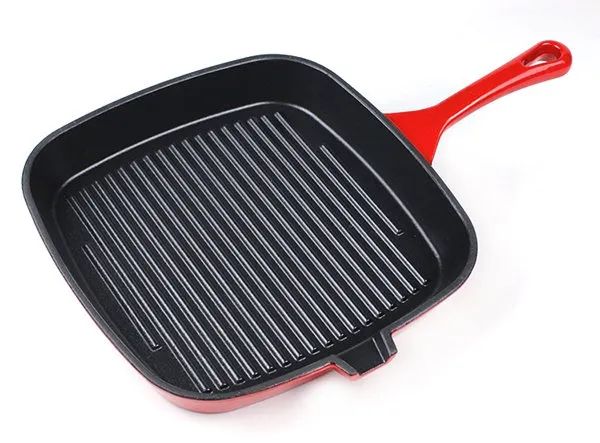How a Meat Weight Press Enhances Flavor
The art of grilling transcends mere cooking—it’s a dance of heat, chemistry, and technique. Among the tools elevating this craft, the meat weight press stands out, transforming ordinary cuts into culinary masterpieces. From the humble bacon press to specialized meat press for grill tools, these devices harness scientific principles to amplify flavor, texture, and consistency. This article delves into the chemistry and physics behind pressing meat, explores the evolution of these tools, and highlights their growing role in wholesale markets serving professional kitchens and outdoor enthusiasts.

The Maillard Reaction and Even Contact: Why Meat Weight Press Matters
The meat weight press owes its magic to the Maillard reaction—a chemical process where amino acids and reducing sugars create complex flavors and aromas when exposed to heat. By pressing meat firmly onto a cooking surface, a meat press for grill ensures maximum contact, accelerating this reaction. The result? A deeper sear, richer crust, and enhanced umami notes.
Pressure also eliminates air pockets, allowing even heat distribution. For example, a bacon press flattens strips, preventing curling and ensuring uniform crispiness. In wholesale settings, this science-driven efficiency appeals to commercial kitchens needing consistent results across high-volume orders.
Furthermore, the consistent pressure applied by a meat weight press helps to extract juices and marinades more evenly, enhancing the flavor penetration into the meat. This means that not only is the exterior of the meat cooked to perfection, but the interior is also infused with delicious flavors. For instance, when making pressed sandwiches with deli meats, the press ensures that every bite is juicy and flavorful, with no dry or overcooked patches. In retail settings, this attention to detail can significantly elevate customer satisfaction and drive repeat purchases.
From Bacon Press to Meat Press for Grill: Evolution of Design
The bacon press, a simple weighted tool, originated in early 20th-century kitchens to keep bacon flat during frying. Over time, its design evolved into the meat press for grill, engineered with heavier materials (like cast iron) and larger surfaces to accommodate steaks, burgers, and poultry. Modern meat weight press tools feature ergonomic handles, non-stick coatings, and customizable weights, catering to diverse cooking styles.
Wholesale manufacturers have standardized these designs for bulk production. Cast iron remains a staple due to its heat retention, while stainless steel variants offer lighter alternatives. This evolution reflects a blend of tradition and innovation, meeting the demands of both backyard grillers and Michelin-starred chefs.
Meat Weight Press in Commercial Kitchens: Wholesale Benefits
For restaurants and food trucks, the meat weight press is a cost-effective workhorse. Bulk purchases of standardized meat press for grill tools streamline operations, ensuring every burger or steak meets quality benchmarks. Wholesale suppliers prioritize durability, offering preseasoned cast iron presses that withstand thousands of uses without warping.
Economies of scale make these tools accessible:
Cost Efficiency: Bulk orders reduce per-unit costs by 30–50%, ideal for chains outfitting multiple locations.
Custom Branding: Wholesalers often laser-etch logos onto bacon press tools, enhancing brand visibility in commercial settings.
Sustainability: Long-lasting materials minimize waste, aligning with eco-conscious procurement policies.
Material Science: Choosing the Right Meat Weight Press
The efficacy of a meat weight press hinges on its material. Cast iron, the gold standard, excels in heat retention and durability but requires seasoning. Stainless steel offers rust resistance and lighter handling, while aluminum variants heat quickly but lack heft.
Wholesale buyers prioritize cast iron for its versatility and longevity. Advanced manufacturing techniques, like sand-casting and enamel coatings, ensure consistent quality in bulk batches. For high-heat environments, composite materials (e.g., cast iron with silicone handles) bridge functionality and safety.
Frequently Asked Questions About Meat Weight Presse
What’s the difference between a bacon press and a meat press for grill?
A bacon press is typically smaller and lighter, designed for thin cuts like bacon. A meat press for grill is heavier, with a larger surface area to handle steaks, burgers, and poultry.
How does a meat weight press improve flavor?
By ensuring even contact with heat, it enhances the Maillard reaction, creating a richer crust and locking in juices.
What materials are best for wholesale meat weight press?
Cast iron dominates wholesale markets for its durability and heat retention. Stainless steel is a close second for low-maintenance kitchens.
Can I use a bacon press for other meats?
Yes, but it’s ideal for thinner cuts. For thicker meats, opt for a heavier meat weight press.
How do wholesalers ensure bacon press quality in orders?
Reputable suppliers conduct batch testing for heat tolerance, weight consistency, and finish durability, often offering warranties.
From backyard BBQs to bustling steakhouses, the meat weight press is a testament to the marriage of science and culinary artistry. By understanding the principles behind its design and embracing wholesale innovations, chefs and retailers alike can elevate their craft—one perfectly seared cut at a time.
-
The Science of Enameled Cast Iron Baking Panవార్తలుJun.09,2025
-
The Rise of the Big Cast Iron Griddle in Outdoor Cooking Cultureవార్తలుJun.09,2025
-
Multi-Use Magic of Cast Iron BBQ Grill Panవార్తలుJun.09,2025
-
Historical Roots of the Casserole Cast Iron Potవార్తలుJun.09,2025
-
Essential Accessories for Mastering Dutch Oven Campingవార్తలుJun.09,2025
-
Why Ecast Iron Grills Are Heating Up Outdoor Cookingవార్తలుMay.23,2025
-
Why Cast Iron Cookware Belongs in Every Kitchen?వార్తలుMay.23,2025
